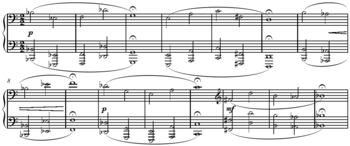
Back Twaalftoonmusiek Afrikaans Zwölftontechnik ALS طريقة الاثنتي عشرة نغمة Arabic Dodecafonismu AST Dodekafoniya Azerbaijani Додекафония Bulgarian Dodecafonisme Catalan Dodekafonie Czech Tolvtonemusik Danish Zwölftontechnik German

The twelve-tone technique—also known as dodecaphony, twelve-tone serialism, and (in British usage) twelve-note composition—is a method of musical composition. The technique is a means of ensuring that all 12 notes of the chromatic scale are sounded equally often in a piece of music while preventing the emphasis of any one note[3] through the use of tone rows, orderings of the 12 pitch classes. All 12 notes are thus given more or less equal importance, and the music avoids being in a key.
The technique was first devised by Austrian composer Josef Matthias Hauer,[not verified in body] who published his "law of the twelve tones" in 1919. In 1923, Arnold Schoenberg (1874–1951) developed his own, better-known version of 12-tone technique, which became associated with the "Second Viennese School" composers, who were the primary users of the technique in the first decades of its existence. Over time, the technique increased greatly in popularity and eventually became widely influential on Mid 20th-century composers. Many important composers who had originally not subscribed to or actively opposed the technique, such as Aaron Copland and Igor Stravinsky,[clarification needed] eventually adopted it in their music.
Schoenberg himself described the system as a "Method of composing with twelve tones which are related only with one another".[4] It is commonly considered a form of serialism.
Schoenberg's fellow countryman and contemporary Hauer also developed a similar system using unordered hexachords or tropes—independent of Schoenberg's development of the twelve-tone technique. Other composers have created systematic use of the chromatic scale, but Schoenberg's method is considered to be most historically and aesthetically significant.[5]


